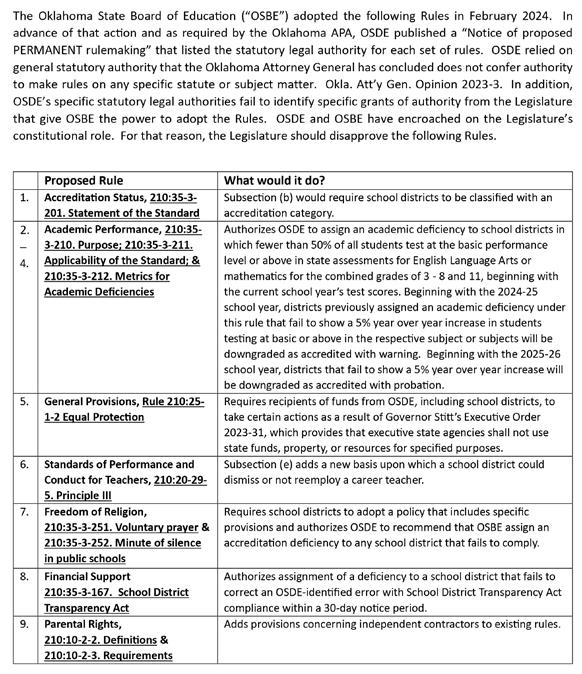
3 minute read
Approved or Disapproved? In this legislative update, we’re diving into the administrative rules process.
By Dr. Jeanene Barnett, CCOSA Education Policy & Research Analyst
This year, the Oklahoma State Department of Education (OSDE) has proposed more Administrative Rules, new and amended, than in recent history. The subject of these rules changes range from a change in district accreditation status based on a new definition of academic deficiency to failure to comply with a new definition of voluntary prayer. What is the purpose of this flurry of new rules? Is the OSDE usurping the legislature’s authority by proposing some new rules without proper authority? A review of the process for rules to become law can help us better understand what is at stake.
Oklahoma’s Administrative Procedures Act defines the road from approved rule to final law. As stated on the Oklahoma Secretary of State’s website, “The Administrative Procedures Act [75 O.S. §§ 250 et seq.] sets out a comprehensive process that provides YOU with the opportunity to participate in the rulemaking process. State agencies are required to accept public comment about proposed rules, notify you if you have requested advance notice of rulemaking proceedings, and may also hold hearings on proposed rules.” has the authority to approve or disapprove the rule. The legislature’s role is clearly laid out in 75 O.S. § 250.2 (OSCN 2024), and it has “a right to disapprove a proposed permanent, promulgated, or emergency rule at any time if the Legislature determines such rule to be an imminent harm to the health, safety, or welfare of the public or the state or if the Legislature determines that a rule is not consistent with legislative intent.”
In K-12 education, the process for rules to become law and entered into the Oklahoma Administrative Code (OAC) begins with Oklahoma State Department of Education (OSDE) and State Board of Education (SBE) approval. The agency proposes a new Administrative Rule in response to legislation that calls for the agency to promulgate rules, or the agency may propose an amendment to an existing rule. These proposals often include a notice period (usually 30 to 60 days) during which the public can provide comments or feedback. The agency usually holds public hearings to gather additional input.
Oklahoma has approximately 150 regulatory agencies. All agency rules, including those from the OSDE as well as other state agencies, are reviewed through the House and Senate Administrative Rules Committees and then submitted to the full bodies with all or some rules identified for approval and some identified for disapproval. The two chambers consider the committees’ recommendations and vote on the rules through a Joint Resolution.
Upon approval or disapproval by the legislature, the rules package then moves to the Governor for consideration. Final approved rules must then be published in the Oklahoma Register and will not become effective until at least 10 days after publication. When the rule goes into effect on the specified date, from that point forward, it carries the force of law and must be followed by affected parties. Most rules impacting Oklahoma public schools are published through the Oklahoma Administrative Code (OAC), Section 210
As part of its work on behalf of public education, CCOSA routinely provides comments like the ones in this document to proposed Administrative Rules.
The next step, after the public comment period closes, requires OSDE to consider the public comment feedback and decide whether to move forward with its proposed rules as originally proposed or with modifications. This past year, the agency has made only a few minor changes to proposed rules based on public comment. In the past, many substantive changes have been made in response to public comments, or the rule has been discarded entirely. If SBE ultimately approves the proposed rules, the agency must submit the final rule to the Oklahoma legislature for review. The legislature then
Throughout this process, transparency and public participation are essential elements to ensure that agency rules are fair, reasonable, and aligned with legislative intent. Any divergence from the statutory procedures governing Administrative Rules compromises legislative intent and potentially saddles school districts with new laws that could be harmful to schools and communities. An April 18 “Oklahoma Voice” article provides an overview of the Administrative Rules process and legislative discussions surrounding OSDE and SBE rules changes, and references a 2023 Attorney General’s opinion requiring passage of a law before an agency can promulgate rules.
To learn more about the Administrative Rules process, Oklahoma’s official rules, rulemaking notices, and executive orders are compiled in The Oklahoma Register and the Oklahoma Administrative Code by the Office of Administrative Rules, which is a division of the Secretary of State. ■ challenges; we’re anticipating the needs of tomorrow, securing a foundation for education where every student can thrive in safety and confidence. and endpoint security.

Our Dual Defense expertise focuses on both physical security and cybersecurity solutions, ensuring that students and teachers can concentrate on the most important aspect of school: learning and growth.


Physical Security: State-of-the-art access control, surveillance, and entry management.


E-rate Service Provider: Our dedicated E-rate team ensures we are meeting deadlines and compliance requirements.


Seamless Integration: A unified approach ensures complete coverage and peace of mind. Ongoing IT Support: Serving as your entire IT department or filling in specific hard-to-staff areas.











